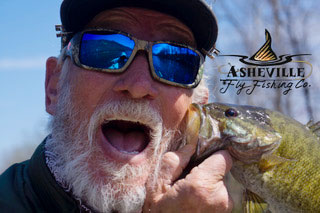Water temperature will tell you a great deal about what the smallmouth are doing and where they are. In the spring, when water temperatures are in the 60-70 degree range, Smallmouth will be near oxygenated water and/or deep holes. For example, wherever you have a rocky, shallow shoal or rapid in a river, there usually lies a deep hole on the downstream side of the shoal or rapid. The water tumbling over itself as it passes over the shoal is a highly oxygenated area; therefore, making the deep hole on the downstream side a likely location to find fish. Smallmouth will rest in the deepest portion of the hole and move to its adjacent fingers to feed.
Oxygenated water types like this offer fish a place to cool or warm their body as needed, depending on the season. Similarly, a south facing section of river will be more productive fishing during spring, because it offers warmer water temperatures for the fish. Subsurface flies are typically most productive in these water types. You want the fly to get into the strike-zone fast, and stay there as long as possible. The deeper and faster the water, the faster your fly needs to fall. Since we are talking about river fishing, keeping your fly in one place on a river, in fast moving water, can be challenging. Aside from color and water clarity, choose your fly according to depth and how fast the water is moving. If the deep hole is big, with no structure or obstruction to get snagged on, a non-weighted fly on a sinking line will get the job done. If the deep hole is small and fast, I find a weighted fly on a floating line and fluorocarbon leader, works best. You want it to plummet. A fly that plummets will also have an augmented margin of up-and-down motion when stripping. Articulated flies enhance the side-to-side motion and give off vibrations when stripped fast. The combination of these two characteristics is effective, and something to consider when choosing your fly.
If you are fishing a popper aggressively and the fish are not responding, try slowing down. Present the fly with a more natural, realistic behavior instead of just trying to tick them off. Make a cast, let the fly smack the water, and let the rings dissipate. Pop it again and wait 10 seconds. Pop it again and skate it across the surface a couple feet, creating a wake behind the fly. Then pick it up and do the same thing in the next best spot. If you do this every 15 feet on a five mile section of river, that’s about 2700 casts and 5500ish pops or wiggles. It’s hard work, especially if you are throwing big flies with a 7wt. or 8wt. rod. This type of fishing is not easy and being able to double haul cast will help your arm last the day and allow you to tuck your fly into the nooks and crannies.
Galen Kipar is a guide and owner at Asheville Fly Fishing Company. He is a problem solver who enjoys the connections and process just as much as the pull. Reservations: (828) 779-9008 Information: AshevilleFlyFishingCo.com

